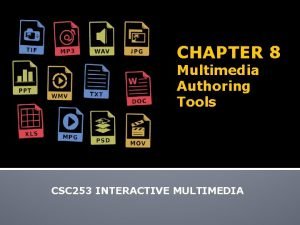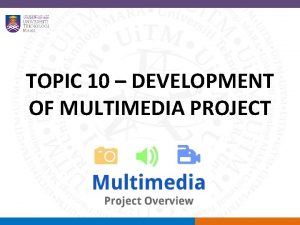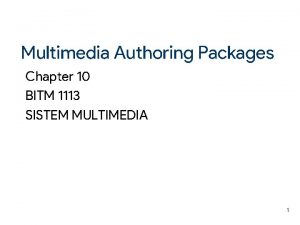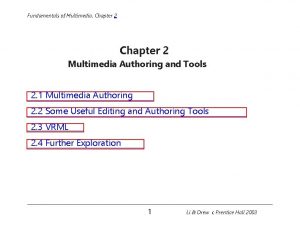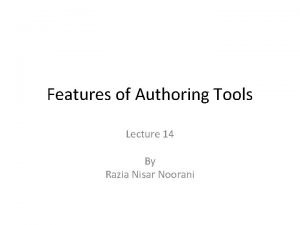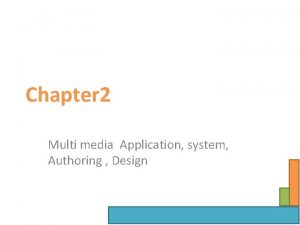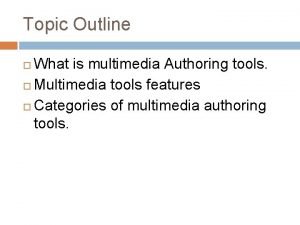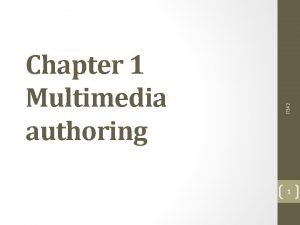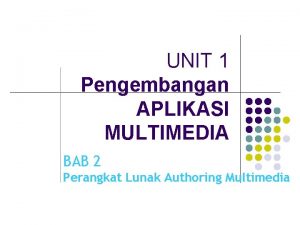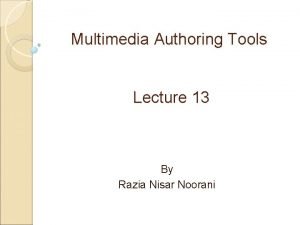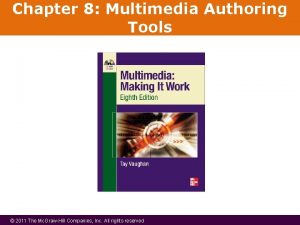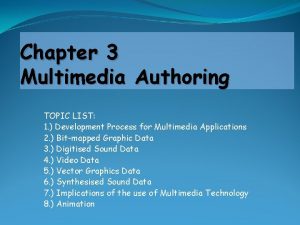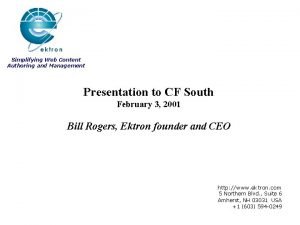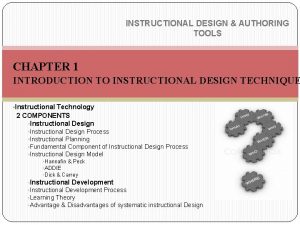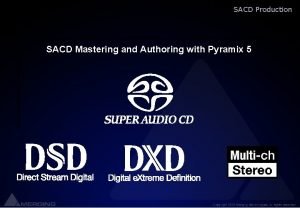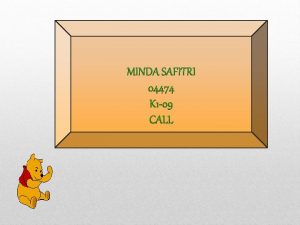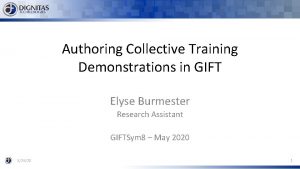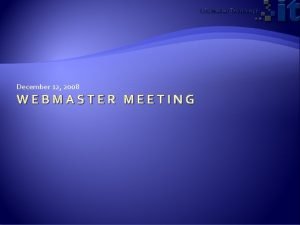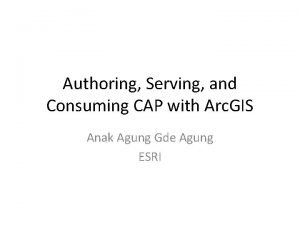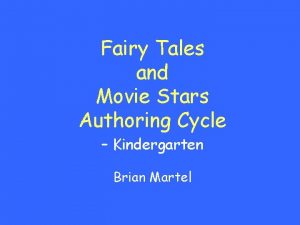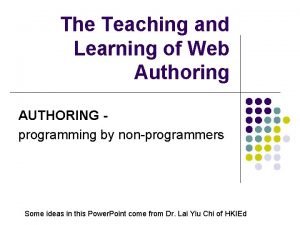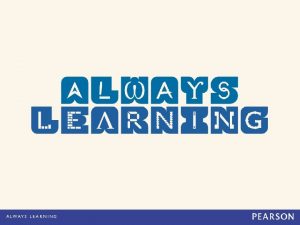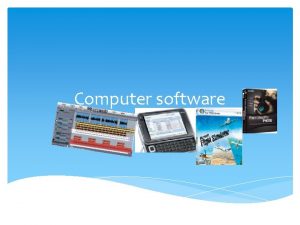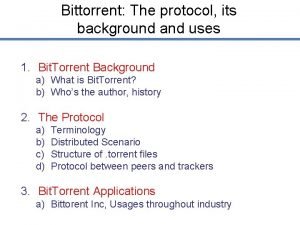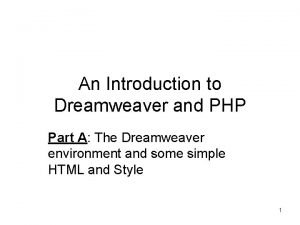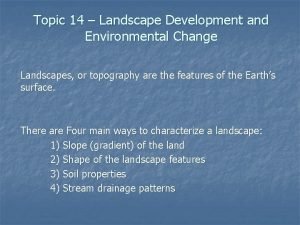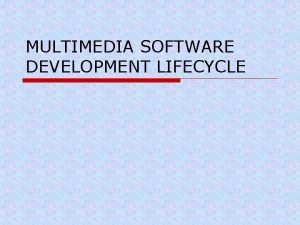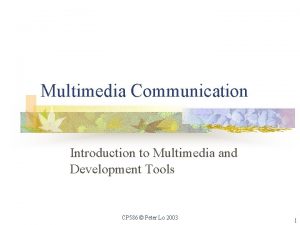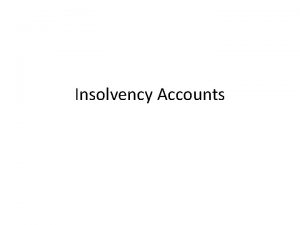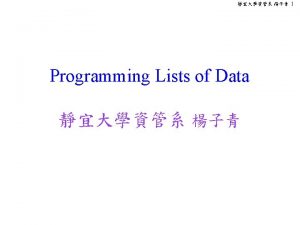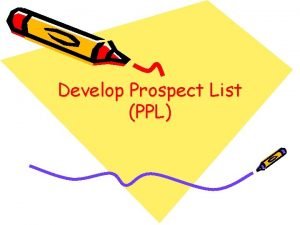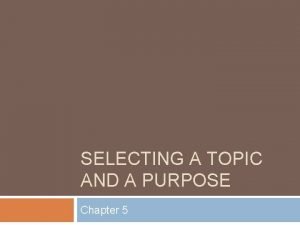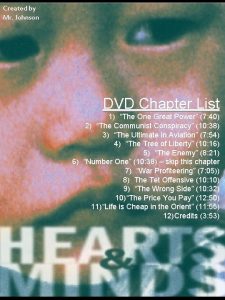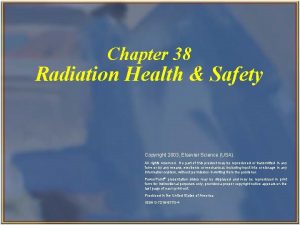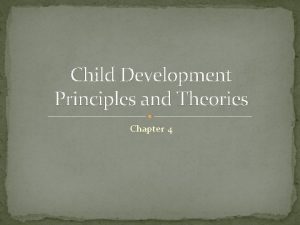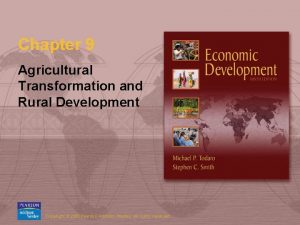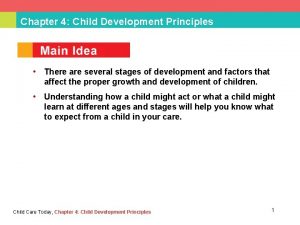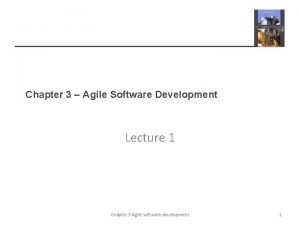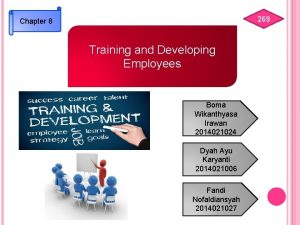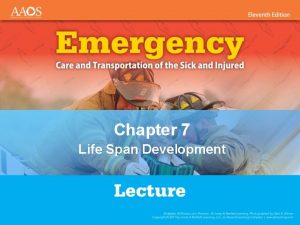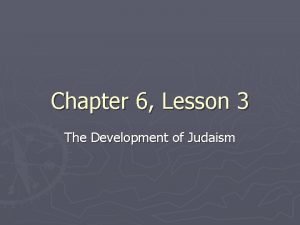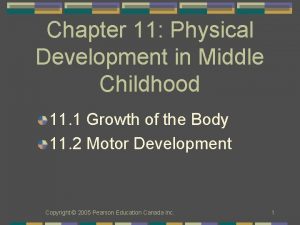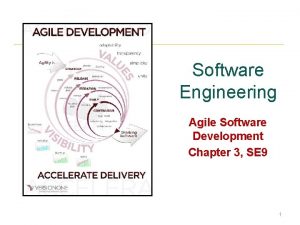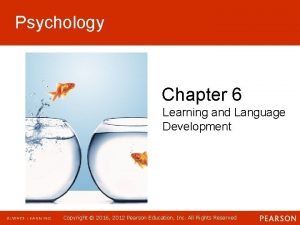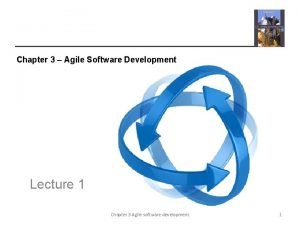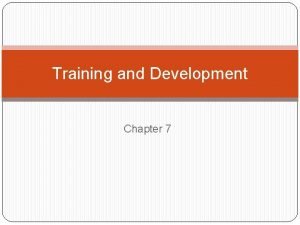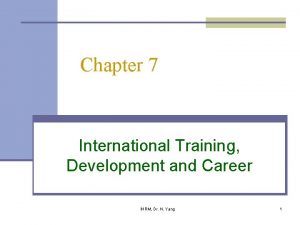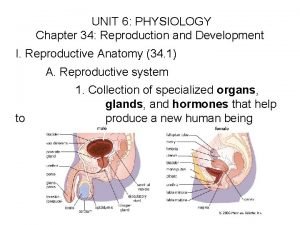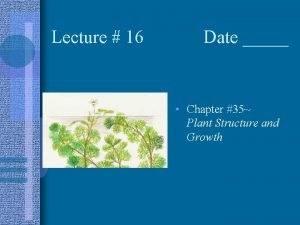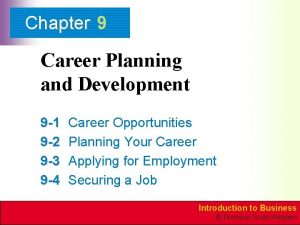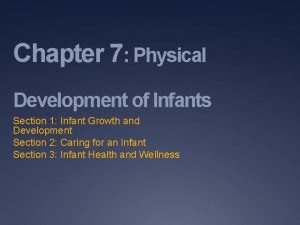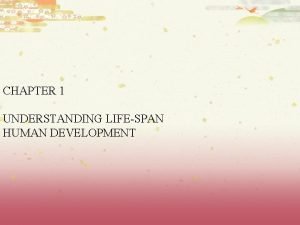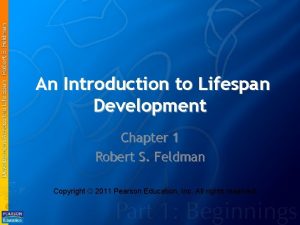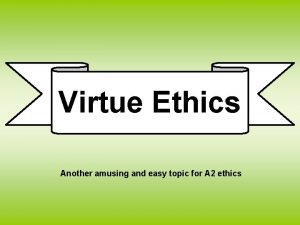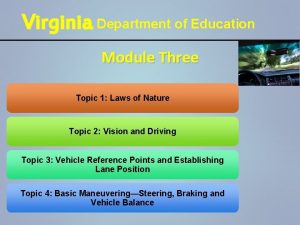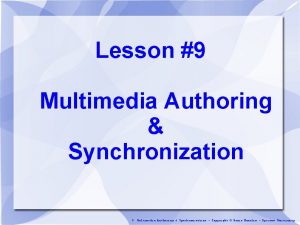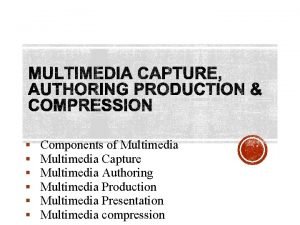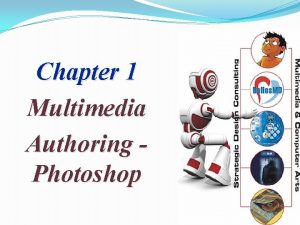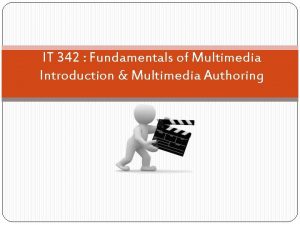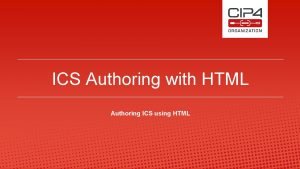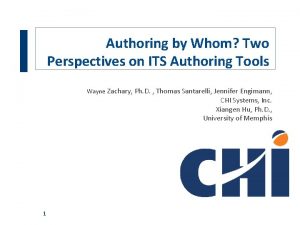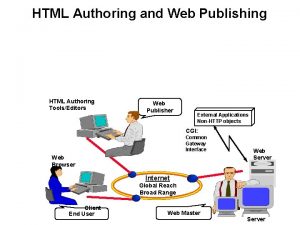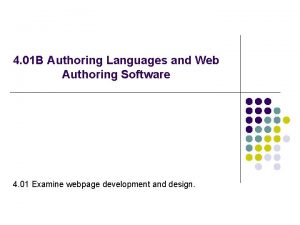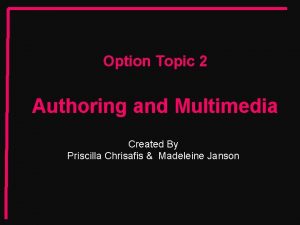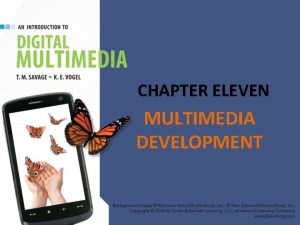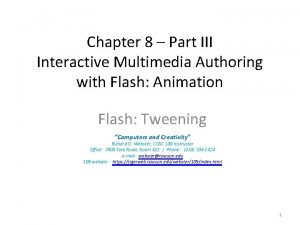Chapter 3 Multimedia Authoring TOPIC LIST 1 Development



































































































- Slides: 99

Chapter 3 Multimedia Authoring TOPIC LIST: 1. ) Development Process for Multimedia Applications 2. ) Bit-mapped Graphic Data 3. ) Digitised Sound Data 4. ) Video Data 5. ) Vector Graphics Data 6. ) Synthesised Sound Data 7. ) Implications of the use of Multimedia Technology 8. ) Animation

What is Multimedia? An interactive piece of software using several types of media: Text Graphics (photographs or illustrations) Audio (synthesised or digitised) Video Animation Multimedia Applications can be: Linear or non-linear Simple or extremely complex For example: Power. Point presentation Sophisticated and basic web pages Multimedia games

The Development Process/Cycle Analysis Design may change if application does not work as expected Implementation Testing Documentation Evaluation Maintenance

DEVELOPMENT PROCESS for MULTIMEDIA APPLICATIONS Analysis Stage This stage is make it absolutely clear what the project is supposed to do. The aims of the application Who will be using it? What will be in it? How will it be distributed? How much money can be spent? How long have you got? Input/output? At the end of the stage a requirements specification will be produced.

DEVELOPMENT PROCESS for MULTIMEDIA APPLICATIONS Design Stage Navigation structure? The HCI (Human Computer Interface) What does each screen look like? What media elements will be included? Storyboards may be produced for this.

DEVELOPMENT PROCESS for MULTIMEDIA APPLICATIONS Implementation Stage �Make it: �Create and combine all the media elements using the pre-decided authoring software. Testing Stage n Does each screen and link work as expected? n If not can it be fixed or does it have to have the design altered.

DEVELOPMENT PROCESS for MULTIMEDIA APPLICATIONS Documentation Stage Write the documentation: The technical guide What are the hardware requirements The user guide Advice on how to use the software and provide users with any other help.

DEVELOPMENT PROCESS for MULTIMEDIA APPLICATIONS Evaluation Stage Does it meet the specifications made at the analysis stage? Maintenance Stage n n Fixing any bugs that have been found after its released. Adapting and updating the application to suit clients needs.

DEVELOPMENT PROCESS for MULTIMEDIA APPLICATIONS Multimedia Authoring Section 1: The Development Process

DEVELOPMENT PROCESS for MULTIMEDIA APPLICATIONS The Development Process mnemonic Analysis Design Implementation Testing Documentation Evaluation Maintenance A Dance In The Dark Every Monday

DEVELOPMENT PROCESS for MULTIMEDIA APPLICATIONS Methodologies used in creation of multimedia applications Text editor: �Application is created using plain text �e. g. Creating simple web pages using HTML. WYSIWIG editors: �Previewing applications under development to check that What You See Is What You Get. �E. g. Power. Point to create a presentation

DEVELOPMENT PROCESS for MULTIMEDIA APPLICATIONS WYSIWYG

DEVELOPMENT PROCESS for MULTIMEDIA APPLICATIONS Text Editor

DEVELOPMENT PROCESS for MULTIMEDIA APPLICATIONS WYSIWYG Vs Text Editors Advantages Text Editor WYSIWYG Disadvantages Simple and places less demands on system. Difficult to Visualise output Provides greater control over the application Dependant on programming or text-based commands knowledge Easy creation and editing of application Complex software that puts higher demands on system. Ideal for beginners Software tends to be expensive

DEVELOPMENT PROCESS for MULTIMEDIA APPLICATIONS Methodologies used in creation of multimedia applications Authoring Software �Application can be customised using: �Program code or scripting � Icon based setting up of properties (without the need to learn programming code) Presentation Software �Enables the creation of a sequence of slides �Allows hyper linking to different slides or files

DEVELOPMENT PROCESS for MULTIMEDIA APPLICATIONS File Players �If a Multimedia Authoring package has been used to create an application the a file player is used to view it. �These players can often be downloaded for free from the internet. �One of the more popular file players & authoring packages is Macromedia Flash

DEVELOPMENT PROCESS for MULTIMEDIA APPLICATIONS Executable Files �Some authoring packages can also save multimedia applications as Executable Files �These are files which will then run as an application themselves �There is no need for a separate player/browser to be used to view these applications

DEVELOPMENT PROCESS for MULTIMEDIA APPLICATIONS Browsers �Once a multimedia application has been developed a browser can be used to view it. �A browser is the program that you use to navigate the WWW and display web pages to you �Once a web page is created the authoring package will save an HTML file that is then viewed in the browser

DEVELOPMENT PROCESS for MULTIMEDIA APPLICATIONS Methodologies used in creation of multimedia applications �Who makes authoring software? �Macromedia � Flash, Dreamweaver and Director �Microsoft � Front. Page �Adobe � Go. Live �Others � Mediator, Hyper. Studio, etc

DEVELOPMENT PROCESS for MULTIMEDIA APPLICATIONS Methodologies used in creation of multimedia applications �Who makes presentation software? �Microsoft � Power. Point (Most common) �Others � Liquid. Media � Cre 8 � Many others exist but not common

DEVELOPMENT PROCESS for MULTIMEDIA APPLICATIONS Creating Multimedia Applications Intermediate 2 Multimedia Technology

DEVELOPMENT PROCESS for MULTIMEDIA APPLICATIONS Multimedia Applications �These are any applications which include more than one type of media �i. e. text, sound, graphics & video �These could include: �Web Pages �Presentations

DEVELOPMENT PROCESS for MULTIMEDIA APPLICATIONS How are they made? �There a number of ways to create these applications: � Using a text editor to create web pages through HTML � Using a WYSIWYG web-page authoring package � Using multimedia authoring software to create complex multimedia applications � Using Presentation software to create presentations

DEVELOPMENT PROCESS for MULTIMEDIA APPLICATIONS WYSIWIG Editors �WYSIWYG stands for ‘What You See Is What You Get’ �This allows you to create your page whilst showing you exactly how the final page will appear on screen �You do not need to know any HTML to create web pages using a WYSIWYG editor

DEVELOPMENT PROCESS for MULTIMEDIA APPLICATIONS Multimedia Authoring Packages �There are now a wide range of authoring packages available to help create multimedia applications �They all use a Graphical User Interface (GUI) �The GUI allows the developer to easily position objects such as graphics, buttons, etc and add events to them.

DEVELOPMENT PROCESS for MULTIMEDIA APPLICATIONS Presentation Software �Software such as Power. Point can be used to create Multimedia applications �This software has �Templates to help structure slides �Can automatically link your slides together �Allows you to easily add sound, graphics, animations and videos.

DEVELOPMENT PROCESS for MULTIMEDIA APPLICATIONS Browsers �Once a multimedia application has been developed a browser can be used to view it. �A browser is the program that you use to navigate the WWW and display web pages to you �Once a web page is created the authoring package will save an HTML file that is then viewed in the browser

DEVELOPMENT PROCESS for MULTIMEDIA APPLICATIONS File Players �If a Multimedia Authoring package has been used to create an application the a file player is used to view it. �These players can often be downloaded for free from the internet. �One of the more popular file players & authoring packages is Macromedia Flash

DEVELOPMENT PROCESS for MULTIMEDIA APPLICATIONS Executable Files �Some authoring packages can also save multimedia applications as Executable Files �These are files which will then run as an application themselves �There is no need for a separate player/browser to be used to view these applications

DEVELOPMENT PROCESS for MULTIMEDIA APPLICATIONS Glossary Task �Add the following words to your glossary with appropriate definitions: �WYSIWYG �Browser �Multimedia Authoring Package �GUI �File Player

DEVELOPMENT PROCESS for MULTIMEDIA APPLICATIONS Written Exercise �Write down a list of the authoring software, presentation software, browsers and file players you have used in the past and a description of what each is. �Have this checked by your teacher.

DEVELOPMENT PROCESS for MULTIMEDIA APPLICATIONS Authoring Vs Presentation Authoring Presentation Advantages Disadvantages Advanced features give developer more control over final application Difficult to learn, special training generally required Simple commands Limited features Easy to learn Can be difficult to debug complex application

Bit-Mapped Graphic Data: Storage of Graphic Data Multimedia - Section 2

BIT-MAPPED GRAPHIC DATA Capturing Still Data �Digital Camera �Re-useable storage �Removable storage (Memory Cards) �Use electronic circuits called Charge Coupled Devices (CCD’s).

BIT-MAPPED GRAPHIC DATA Charge Coupled Devices (CCD’s) �uses sensors to capture the image projected by the lens. �When a digital camera takes a photograph, the lens opens and lets light into the camera. �The CCD turns the light coming from the lens into analogue signals �Passed on to a processor which samples them and converts them into digital data.

BIT-MAPPED GRAPHIC DATA Capturing Still Data � Scanners also use CCD’s � Scanners have CCDs in a moveable scan head which passes over the document. � The CCDs convert the light being reflected off the document into an analogue signal. � converted to binary form and stored in the computer system attached to the scanner. � Unlike cameras, scanners do not have storage devices, so they can only be used when connected to a computer.

Activities: p. 3 - Multimedia Photo Editing LTS notes

BIT-MAPPED GRAPHIC DATA File Formats Bitmap (BMP) Graphic Interchange Format (GIFF) Joint Pictures Expert Group (JPEG) Portable Network Graphics (PNG)

BIT-MAPPED GRAPHIC DATA Bitmap File Format Uncompressed: �A file which holds a binary number for each pixel in an image Limitation: �large file size Extension: �. bmp

BIT-MAPPED GRAPHIC DATA Bitmap File Format Colour Depth The number of colours that can be represented Calculation: Number of colours = 2 bit depth

BIT-MAPPED GRAPHIC DATA Example Colour (bit) Depth = 8 Number of colours = 28 =2 x 2 x 2 = 256

BIT-MAPPED GRAPHIC DATA GIF File Format Lossless compression A code is used to store repeated patterns in the image Limited number of colours: limited to 28 256 colours Features: Animation Transparency Extension: . gif

BIT-MAPPED GRAPHIC DATA GIF File Format Good For: Flat areas of colour Few colours Animated images Transparency Bad For: Photographic images High colour graphics High quality videos

BIT-MAPPED GRAPHIC DATA JPEG File Format Lossy compression File size is reduced by removing sections of the graphic that will no be noticed by the human eye Greyscale or full-colour image compression Exploits human eye limitations Related to MPEG Extension: . jpg

BIT-MAPPED GRAPHIC DATA JPEG File Format Advantages: Greater compression than lossless Good for photographic images (real-world) Compression ratio can be controlled by user Best for large files Disadvantages Doesn’t support transparency

BIT-MAPPED GRAPHIC DATA PNG File Format Has all advantages of GIF without the restrictions Allows 24 bit colour Allows for partial transparency Lossless compression Variation of JPG compression Extension: . png

BIT-MAPPED GRAPHIC DATA Resolution �The amount of detail in an image. �Measured in Dots Per Inch (dpi)

BIT-MAPPED GRAPHIC DATA Bit Mapped Graphics: Creation �Paint �Image Editing Programs àDecrease resolution àAlter Colour Depth àCrop àAlter Brightness & Contrast àRe-size or Scale àSpecial Effects

BIT-MAPPED GRAPHIC DATA Graphics Card A device which controls the quality of output on a monitor. There a wide range available designed to assist the computer in achieving overall high performance.

Multimedia Autoring: Digitised Sound Data Section 3

DIGITISED SOUND DATA Sound in Multimedia Sound can make multimedia presentations dynamic and interesting. They can also be used to assist user. Types: Voice Over Special Effects Musical Backdrops

DIGITISED SOUND DATA Sound Capture Microphone: Analogue Can be used for voice-overs CD/DVD: Digital Capturing music files Copyright laws may apply

DIGITISED SOUND DATA Sampling Frequency Once an analogue signal is received it is chopped up and a sample is taken The sampling frequency is the number of samples taken per second. Samples of Sound Wave

DIGITISED SOUND DATA Sampling Frequency �Measurements (or samples) will be taken many times each second �The sampling rate for audio CD is 44. 1 k. HZ means 44100 thousand samples per second.

DIGITISED SOUND DATA Sampling Depth �This describes the number of bits which are taken in each sample • This will determine the dynamic range of the recording • An audio CD will have a sampling depth of 16 bits (65536 levels)

Multimedia Authoring: Digitised Sound Data Storage of Sound Data

DIGITISED SOUND DATA RAW Uncompressed audio data Sampled digital data which has not been processed further

DIGITISED SOUND DATA WAV File Wave files are files containing digitised sound data Often used in places such as digital telephone systems and minidisc players. File size is smaller than RAW but there is no loss of quality

DIGITISED SOUND DATA MP 3 MPEG Audio Layer-3 (MP 3) Uses lossy compression Based on what humans hear best Perceptual Audio Compression Reduces RAW formats to around 10% of original size 3 min of CD quality song = 30 Mb 3 min of MP 3 = 3 Mb Quality is adjustable

DIGITISED SOUND DATA File Size Vs Quality Sampling depth: increased sound depth = = Greater range of values Better sound quality and greater file size. • Sampling frequency: The higher the sampling frequency, the better the sound quality, the greater the file size. Sound time: Longer track lasts the larger the file size Affects file size but not quality.

DIGITISED SOUND DATA Comparing Bitmap image files and digitised sound files Each sample records data for a pixel Bitmap graphical data: Resolution Sound data: Frequency Bitmap: Number of bits for each sample/number of colours used Colour depth Sound: Number of bits determines number of signal levels that can be recorded Sampling Depth

DIGITISED SOUND DATA Sound Carry out the following jobs: àRecording Audio àPlayback or digitised audio àPlayback of Audio CD’s àSound Synthesis àInterfacing with MIDI instruments, Digital Input and Output for transferring files.

DIGITISED SOUND DATA Sound Editing Crop Effects Echo Reverse Volume

Video Data Section 4: Multimedia Technology

VIDEO DATA What is Video? �A video is just a collection of bit-mapped images that when played quickly one after another give the illusion of a moving image �It is a sequence of individual pictures or frames �The standard rate at which these frames are taken is 25 frames per second (this gives realistic movement)

VIDEO DATA Input (Capture): Digital Video Camera (Camcorders) �Work in the same way as digital cameras �They use the same light sensors, called CCDs �They have a lower resolution than cameras �They are designed to capture lots of images (frames) fast

VIDEO DATA Input (Capture): Webcam �Designed for the purpose of creating videos to be transmitted over the Internet �They do not need to be high resolution, keeping down the bit rates and price. �They use low resolution array CCDs and low quality lenses, keeping costs down

VIDEO DATA Input (Capture): Video Capture Card �A video capture card is needed to capture videos from analogue sources �video tape players, television broadcasts and analogue video recorders �Some modern graphics cards include the ability to capture video

Video Data: Storage of Video data Section 4: Multimedia Technology:

VIDEO DATA AVI (Audio Video Interleave) Uncompressed �AVI ratio set during saving �The audio is embedded into the video at different intervals.

VIDEO DATA MPEG �Lossy compression cuts out unnecessary parts of a video clip �Saves each frame of video as a JPEG � These are called ‘i-frames’ �Data that stays the same in following frames is removed �The next frames only store data on what has changed since last i-frame

VIDEO DATA MPEG

VIDEO DATA Video Quality And File Size �Colour depth: �Increasing colour depth improves quality and file sizes. �Resolution: �Increasing resolution improves quality and increases file sizes. �Frame rate: �Measured in frames per second (FPS). �Increasing frame rate increases file size. Lower frame rates reduce file size but make video clip ‘jerky’.

Video Quality And File Size �Video time: �increasing or reducing the time of a video is the obvious way to affect the file size. �Quality of the display of the clip is not affected. �Lossy compression: �Using MP 3 compression reduces file sizes without affecting quality.

Video Data: Video Editing Section 4: Multimedia Technology:

VIDEO DATA Timeline � Each frame is displayed as a thumbnail image. � Each frame can be individually edited � The audio would also be on an timeline � Some packages provide multiple timelines

VIDEO DATA Storyboards �Simple plan of final product �Usually freehand rough �Important process for all multimedia applications �Produced at Analysis stage

VIDEO DATA Crop �Basically, cutting or removing the parts you don’t want. �You may want to remove a frame or a whole scene.

VIDEO DATA Sequencing �Once you’ve got your video cropped, edited you have to put it in sequence. �In other words, put it in the correct order BDCA ABCD

VIDEO DATA Transitions �Used to ‘join up’ different scenes/frames �Different types are available, for example: Wipe

VIDEO DATA Transitions �Used to ‘join up’ different scenes/frames �Different types are available, for example: Dissolve

VIDEO DATA Transitions �Used to ‘join up’ different scenes/frames �Different types are available, for example: Box Out

VIDEO DATA Transitions �Used to ‘join up’ different scenes/frames �Different types are available, for example: Fade In

VECTOR GRAPHICS Vector Graphics Multimedia Authoring - Section 5

VECTOR GRAPHICS Vector Graphics �Object oriented or vector drawn graphics are stored by their attributes. �Sometimes referred to as being Scaleable, (independent of resolution). This means the image can be altered without any ‘blurry’ effect. �Draw. Plus is an example of a Vector Graphics Software Package.

VECTOR GRAPHICS Vector Graphics: File Formats �SVG: Scaleable Vector Graphics �VRML: Virtual Reality Mark-up Language �WRL: World Description Language �The above are based upon storing a graphic by is attributes.

SYNTHESISED SOUND DATA Synthesised Sound Data Multimedia - Section 6

SYNTHESISED SOUND DATA MIDI �Musical Instrument Digital Interface �Standard interface to link a musical instrument and a computer. �Enables notes played on an instrument to be saved, edited, and played back through a MIDI device.

SYNTHESISED SOUND DATA MIDI: Attributes � Instrument: Defines which instrument is playing according to the instrument number. � Pitch: Sets the musical tone of a note which is determined by frequency. � Volume: Controls the loudness or amplitude of a note. � Duration: Determines the length of a note (number of beats) � Tempo: The speed at which the piece of music is set.

VECTOR GRAPHICS Implication of Multimedia Technology Multimedia - Section 7

IMPLICATIONS OF MM TECHNOLOGY Discuss the following: �Smartphone �Pocket PC �Digital Television �Virtual Reality

IMPLICATIONS OF MM TECHNOLOGY Task �Pick one of the contemporary technologies listed from the previous slide: �Use MS Power. Point to create a slide show about the device: à 1 x Introduction Slide à 4 x Information Slides à 1 x Conclusion slide § The slideshow must show captured graphic data, edited sound data (use Audacity), and some form of edited video data (use Movie. Plus).

VECTOR GRAPHICS Animation Multimedia - Section 8

Animation Definition �animation refers to the process of adding movements to static images through various methods. Animated movements can be measured in frame per second (fps). The higher the fps, the smoother the transition between frames.

KEYFRAMES AND TWEENING

TWO-DIMENSIONAL ANIMATION (2 D)

Path Animation

Cell Animation

SPECIAL EFFECTS OF ANIMATION �Morphing Warping
 Features of multimedia
Features of multimedia Stage of multimedia project
Stage of multimedia project Released fullblown multimedia authoring system
Released fullblown multimedia authoring system Multimedia authoring metaphors
Multimedia authoring metaphors Features of multimedia authoring tools
Features of multimedia authoring tools Designer now multimedia authoring system
Designer now multimedia authoring system Four main perspectives in multimedia authoring tools
Four main perspectives in multimedia authoring tools Authoring metaphors in multimedia
Authoring metaphors in multimedia Peranti authoring berbasis kartu menyediakan layer
Peranti authoring berbasis kartu menyediakan layer Features of macromedia director
Features of macromedia director Types of authoring tools in multimedia
Types of authoring tools in multimedia Example of clincher sentence
Example of clincher sentence Narrow down topic
Narrow down topic Multimedia becomes interactive multimedia when
Multimedia becomes interactive multimedia when A multimedia project is identified as non-linear when
A multimedia project is identified as non-linear when Chapter 1 introduction to multimedia
Chapter 1 introduction to multimedia Esa multimedia.esa.int./multimedia/virtual-tour-iss
Esa multimedia.esa.int./multimedia/virtual-tour-iss Multi genre project examples
Multi genre project examples Stages of multimedia application development
Stages of multimedia application development Web content authoring
Web content authoring Scorm editor free
Scorm editor free Instructional design authoring tools
Instructional design authoring tools Sacd mastering
Sacd mastering Windows movie maker is an authoring tool.
Windows movie maker is an authoring tool. Elyse burmester
Elyse burmester Web authoring software
Web authoring software Authoring
Authoring Paul neve
Paul neve Visual studio authoring extensions
Visual studio authoring extensions Authoring cycle
Authoring cycle Advantages of web authoring tools
Advantages of web authoring tools Item authoring and banking
Item authoring and banking Microsoft powerpoint is an example of financial software
Microsoft powerpoint is an example of financial software Self authoring torrent
Self authoring torrent Centralized authoring
Centralized authoring Web authoring using adobe dreamweaver - selected response
Web authoring using adobe dreamweaver - selected response Topic 14 landscape development and environmental change
Topic 14 landscape development and environmental change Multimedia software development
Multimedia software development Brief history of multimedia
Brief history of multimedia What is an axiomatic system in geometry
What is an axiomatic system in geometry Singly vs doubly linked list
Singly vs doubly linked list Singly linked list vs doubly linked list
Singly linked list vs doubly linked list List h shows account
List h shows account Pengertian single linked list
Pengertian single linked list Select list item list index too large
Select list item list index too large Pattern of growth and development
Pattern of growth and development Whats ppl
Whats ppl Chapter 5 selecting a topic and a purpose
Chapter 5 selecting a topic and a purpose Chapter 5 selecting a topic and a purpose
Chapter 5 selecting a topic and a purpose Historical development of community development
Historical development of community development Development that ended much development crossword
Development that ended much development crossword Radial line development method is used for development of
Radial line development method is used for development of Dvd chapter list
Dvd chapter list List the properties of x radiation chapter 38
List the properties of x radiation chapter 38 Child development principles and theories
Child development principles and theories Child development chapter 9
Child development chapter 9 Chapter 9 agricultural transformation and rural development
Chapter 9 agricultural transformation and rural development Chapter 9 agricultural transformation and rural development
Chapter 9 agricultural transformation and rural development Chapter 9 career planning and development
Chapter 9 career planning and development Human needs and human development chapter 8
Human needs and human development chapter 8 Chapter 5 diversity and human needs and development
Chapter 5 diversity and human needs and development What are the 4 principles of child development
What are the 4 principles of child development Chapter 36 section 1: reproductive systems answer key
Chapter 36 section 1: reproductive systems answer key Chapter 3 agile software development
Chapter 3 agile software development Chapter 8 training and development
Chapter 8 training and development Chapter 10 physical development from one to three
Chapter 10 physical development from one to three Chapter 9 lifespan development
Chapter 9 lifespan development Introduction to lifespan development
Introduction to lifespan development Chapter 8 human needs and human development
Chapter 8 human needs and human development Chapter 9 early childhood cognitive development
Chapter 9 early childhood cognitive development Child development chapter 1
Child development chapter 1 Chapter 7 life span development
Chapter 7 life span development Chapter 6 the israelites
Chapter 6 the israelites Lesson 3 the development of judaism answer key
Lesson 3 the development of judaism answer key Physical development in middle childhood chapter 11
Physical development in middle childhood chapter 11 Chapter 3 agile software development
Chapter 3 agile software development Chapter 6 learning and language development
Chapter 6 learning and language development Psychology chapter 6 learning
Psychology chapter 6 learning Development of congressional powers chapter 6 answer key
Development of congressional powers chapter 6 answer key Chapter 3 agile software development
Chapter 3 agile software development Method of training
Method of training International training and development in ihrm
International training and development in ihrm Development of congressional powers chapter 6 answer key
Development of congressional powers chapter 6 answer key Chapter 34 reproduction and development answer key
Chapter 34 reproduction and development answer key Chapter 7 human growth and development
Chapter 7 human growth and development Chapter 35 plant structure growth and development
Chapter 35 plant structure growth and development Chapter 9 career planning and development
Chapter 9 career planning and development Chapter 9 career planning and development
Chapter 9 career planning and development Chapter 7 physical development of infants
Chapter 7 physical development of infants Chapter 5 cognitive development in infancy and toddlerhood
Chapter 5 cognitive development in infancy and toddlerhood Primary growth and secondary growth in plants
Primary growth and secondary growth in plants Exploring lifespan development chapter 1
Exploring lifespan development chapter 1 Sociocultural graded influences
Sociocultural graded influences What is a topic sentence
What is a topic sentence Topic sentence
Topic sentence Sexy paragraph structure
Sexy paragraph structure Expository paragraph examples
Expository paragraph examples World schools debate speaker roles
World schools debate speaker roles Easy topic about life
Easy topic about life Module 3: topic 1 laws of nature
Module 3: topic 1 laws of nature
